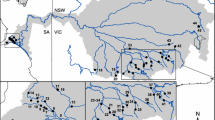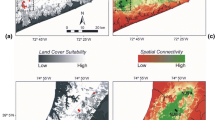Abstract
The delimitation of dispersal routes used by individuals moving between populations has the potential to direct management efforts aimed at limiting the spread of invasive species. Red swamp crayfish (Procambarus clarkii) have successfully invaded aquatic ecosystems across much of the globe, causing loss of biodiversity and habitat destruction. Our research focuses on a Mojave Desert spring system in Ash Meadows National Wildlife Refuge, where a combination of anthropogenic habitat degradation and the establishment of invasive species have caused extinctions, extirpations, and severe population declines of endangered fishes. To infer the invasion history of hydrologically isolated springs, we tested alternative hypotheses of P. clarkii dispersal routes and colonization events throughout Ash Meadows using a landscape genetics approach that combined analysis of microsatellite and mitochondrial DNA genotypes with geographic information system (GIS) mapping. Modeled historic outflows, in conjunction with waterway mapping based on aerial imagery and LiDAR data, show variable drainage routes across the flat topography of Ash Meadows. Estimates of gene flow between P. clarkii populations revealed the drainages utilized by crayfish to move from central to peripheral springs. Additionally, analyses of mtDNA haplotype diversity and distribution suggest isolated springs were colonized by few individuals, and subsequent emigration has been rare. These results will inform ecological restoration in Ash Meadows by directing the placement of barriers to prevent reinvasion of distal springs after eradication of P. clarkii populations. Finally, this research provides a case study for elucidating the functional connectivity of ephemerally connected landscapes, using the integration of genetic and GIS techniques.






Similar content being viewed by others
References
Barbaresi S, Tricarico E, Gherardi F (2004) Factors inducing the intense burrowing activity by the red swamp crayfish, Procambarus clarkii, an invasive species. Naturwissenschaften 91:342–345
Belfiore NM, May B (2000) Variable microsatellite loci in red swamp crayfish, Procambarus clarkii, and their characterization in other crayfish taxa. Mol Ecol 9:2231–2234
Clement M, Posada D, Crandall K (2000) TCS: a computer program to estimate gene genealogies. Mol Ecol 9:1657–1660
Deacon JE, Williams CD (1991) Ash Meadows and the legacy of the Devils Hole pupfish. In: Minckley WL, Deacon JE (eds) Battle against extinction: native fish management in the American West. The University of Arizona Press, Tucson, pp 69–87
Deacon JE, Williams AE, Williams CD, Williams JE (2007) Fueling population growth in Las Vegas: how large-scale groundwater withdrawal could burn regional biodiversity. Bioscience 57:688–698
Dudley WW, Larson JD (1976) Effect of irrigation pumping on desert pupfish habitats in Ash Meadows, Nye County, Nevada. U.S. Geological Survey Professional Paper 927, p 153
Estoup A, Guillemaud T (2010) Reconstructing routes of invasion using genetic data: why, how, and so what? Mol Ecol 19:4113–4130
Estoup A, Baird SJE, Ray N, Currat M, Cornuet JM, Santos F, Beaumont MA, Excoffier L (2010) Combining genetic, historical and geographical data to reconstruct the dynamics of bioinvasions: application to the cane toad Bufo marinus. Mol Ecol Resour 10:886–901
Figler MH, Blank GS, Peeke HVS (2005) Shelter competition between resident male red swamp crayfish Procambarus clarkii (Girard) and conspecific intruders varying by sex and reproductive status. Mar Freshw Behav Phys 38:237–248
Gherardi F, Barbaresi S (2000) Invasive crayfish: activity patterns of Procambarus clarkii in the rice fields of the Lower Guadalquivir (Spain). Archiv fur Hydrbiologie 150:153–168
Gherardi F, Baldaccini GN, Barbaresi S, Ercolini P, De Luise G et al (1999) The situation in Italy. In: Gherardi F, Holdich DM (eds) Crayfish in Europe as alien species. How to make the best of a bad situation? A.A. Balkema, Rotterdam, pp 107–128
Gutierrez-Yurrita PJ, Montes C (1999) Bioenergetics and phenology of reproduction of the introduced red swamp crayfish, Procambarus clarkii, in Donaña National Park, Spain, and implications for species management. Freshw Biol 42:561–574
Hobbs HH (1972) Biota of freshwater ecosystems, identification manual 9: crayfishes (Astacidae) of North and Middle America. Water Pollution Control Research Series. U.S. Environmental Protection Agency, reprinted in 1976
Huner JV (1977) Introductions of the Louisiana red swamp crayfish, Procambarus clarkii (Girard): an update. Freshw Crayfish 3:193–202
Huner JV, Avault JW (1979) Introductions of Procambarus spp. Freshw Crayfish 4:191–194
Huner JV, Lindqvist OV (1995) Physiological adaptations of freshwater crayfishes that permit successful aquacultural enterprises. Am Zool 35:12–19
Kennedy TA, Finlay JC, Hobbie SE (2005) Eradication of invasive Tamarix ramosissima along a desert stream increases native fish density. Ecol Appl 15:2072–2083
Li Y, Gou X, Cao X, Deng W, Luo W, Wang W (2012) Population genetic structure and post-establishment dispersal patterns of the red swamp crayfish Procambarus clarkii in China. PLoS ONE 7:e40652
Lodge DM, Lorman JG (1987) Reductions in submersed macrophyte biomass and species richness by the crayfish Oronectes rustics. Can J Fish Aquat Sci 44:591–597
Maddison DR, Maddison WP (2005) MacClade 4: analysis of phylogeny and character evolution. Version 4.08a. http://macclade.org
Marrs RA, Sforza R, Hufbauer RA (2008) Evidence for multiple introductions of Centaurea stoebe (spotted knapweed, Asteraceae) to North America. Mol Ecol 17:4197–4208
Martin AP (2010) The conservation genetics of Ash Meadows pupfish populations. I. The Warm Springs pupfish Cyprinodon nevadensis pectoralis. Conserv Genet 11:1847–1857
Matsuzaki SS, Usio N, Takamura N, Washitani I (2009) Contrasting impacts of invasive engineers on freshwater ecosystems: an experiment and meta-analysis. Oecologia 158:673–686
Meirmans PG, Van Tienderen PH (2004) GENOTYPE and GENODIVE: two programs for the analyses of genetic diversity of asexual organisms. Mol Ecol Notes 4:792–794
Miller RR (1948) The cyprinodont fishes of the Death Valley system of eastern California and southwestern Nevada. Miscellaneous Publications, Museum of Zoology, Univ of Michigan 68, pp 1–155, Pl. 1–15
Nystrom P, Strand JA (1996) Grazing by a native and an exotic crayfish on aquatic macrophytes. Freshw Biol 36:673–682
Paetkau D, Calvert W, Stirling I, Strobeck C (1995) Microsatellite analysis of population structure in Canadian polar bears. Mol Ecol 4:347–354
Paetkau D, Slade R, Burdens M, Estoup A (2004) Genetic assignment methods for the direct, real-time estimation of migration rate: a simulation-based exploration of accuracy and power. Mol Ecol 13:55–65
Paglianti A, Gherardi F (2004) Combined effects of temperature and diet on growth and survival of young-of-year crayfish: a comparison between indigenous and invasive species. J Crustac Biol 24:140–148
Payne JF (1997) Adaptive success within the cambarid life cycle. Freshw Crayfish 11:1–12
Pejchar L, Mooney HA (2009) Invasive species, ecosystem services and human well-being. Trends Ecol Evol 24:497–504
Pritchard JK, Stephens M, Donnelly P (2000) Inference of population structure using multilocus genotype data. Genetics 155:945–959
Reynolds JD (2002) Growth and reproduction. In: Holdich DM (ed) Biology of freshwater crayfish. Blackwell Science, Oxford, pp 152–191
Rodriguez CF, Becares E, Fernandez-Alaez M (2003) Shift from clear to turbid phase in Lake Chozas (NW Spain) due to the introduction of American red swamp crayfish (Procambarus clarkii). Hydrobiologia 506:421–426
Rodriguez CF, Becares E, Fernandez-Alaez M, Fernandez-Alaez C (2005) Loss of diversity and degradation of wetlands as a result of introducing exotic crayfish. Biol Invasions 7:75–85
Rollins LA, Woolnough AP, Wilton AN, Sinclair R, Sherwin WB (2009) Invasive species can’t cover their tracks: using microsatellites to assist management of starling (Sturnus vulgaris) populations in Western Australia. Mol Ecol 18:1560–1573
Sada DW (1990) Recovery plan for the endangered and threatened species of Ash Meadows, Nevada. U.S. Fish and Wildlife Service, Portland, Oregon, p 123
Sanders NJ, Gotelli NJ, Heller NE, Gordon DM (2003) Community disassembly by an invasive species. Proc Natl Acad Sci USA 100:2474–2477
Scoppettone GG, Rissler P, Johnson D, Hereford M (2011) Relative abundance and distribution of fishes and crayfish at Ash Meadows National Wildlife Refuge, Nye County, Nevada, 2007–2008. U.S. Geological Survey Open-File Report 2011-1017, p 56
Seager R, Ting M, Held I, Kushnir Y, Lu J, Vecchi G, Huang H, Harnik N, Leetmaa A, Lau N, Li C, Velez J, Naik N (2007) Model projections of an imminent transition to a more arid climate in southwestern North America. Science 316:1181–1184
Smouse PE, Peakall R (1999) Spatial autocorrelation analysis of individual multiallele and multilocus genetic structure. Heredity 82:561–573
Soltz KL, Naiman RJ (1978) The natural history of native fishes in the Death Valley system. Natural History Museum of Los Angeles County, California. Science Series v. 30, p 76
Stevens LE, Bailowitz RA (2008) Odonata of Ash Meadows National Wildlife Refuge, southern Nevada, USA. J Arizona-Nevada Acad Sci 40:128–135
Swofford DL (2003) PAUP*. Phylogenetic Analysis Using Parsimony (*and Other Methods). Version 4. Sinauer Associates, Sunderland, Massachusetts
Taylor CA, Knouft JH (2006) Historical influences on genital morphology among sympatric species: gonopod evolution and reproductive isolation in the crayfish genus Oronectes (Cambaridae). Biol J Linn Soc 89:1–12
Torres E, Alvarez F (2012) Genetic variation in native and introduced populations of the red swamp crayfish Procambarus clarkii (Girard, 1852) (Crustacea, Decapoda, Cambaridae) in Mexico and Costa Rica. Aquat Invasions 7:235–241
Vitousek PM, D’Antonio CM, Loope LL, Westbrooks R (1996) Biological invasions as global environmental change. Am Sci 84:218–228
Weissenfluh DS (2008) School Spring Refugium restoration accomplishment report. US Fish and Wildlife Service Report, p 9
Weissenfluh DS (2010) Conservation of Cyprinodon nevadensis pectoralis and three endemic aquatic invertebrates in an artificial desert spring refuge located in Ash Meadows National Wildlife Refuge, Nevada. M.S. Thesis, Texas Tech University
Acknowledgments
We thank the personnel of Ash Meadows National Wildlife Refuge, especially Darrick Weissenfluh and Cristi Baldino, for helping to facilitate field research and providing background information on this project. Kathy Taylor of Argenta Consulting and the staff of USGS-Reno generously provided GIS data. Thanks to Sharon Collinge, Carol Wessman, Loren Sackett, Sierra Love Stowell, and Stower Beals for comments on the manuscript. This research was funded by the U.S. Fish and Wildlife Service, who do not necessarily support the views presented in this manuscript.
Author information
Authors and Affiliations
Corresponding author
Electronic supplementary material
Below is the link to the electronic supplementary material.
Rights and permissions
About this article
Cite this article
Paulson, E.L., Martin, A.P. Discerning invasion history in an ephemerally connected system: landscape genetics of Procambarus clarkii in Ash Meadows, Nevada. Biol Invasions 16, 1719–1734 (2014). https://doi.org/10.1007/s10530-013-0621-x
Received:
Accepted:
Published:
Issue Date:
DOI: https://doi.org/10.1007/s10530-013-0621-x




